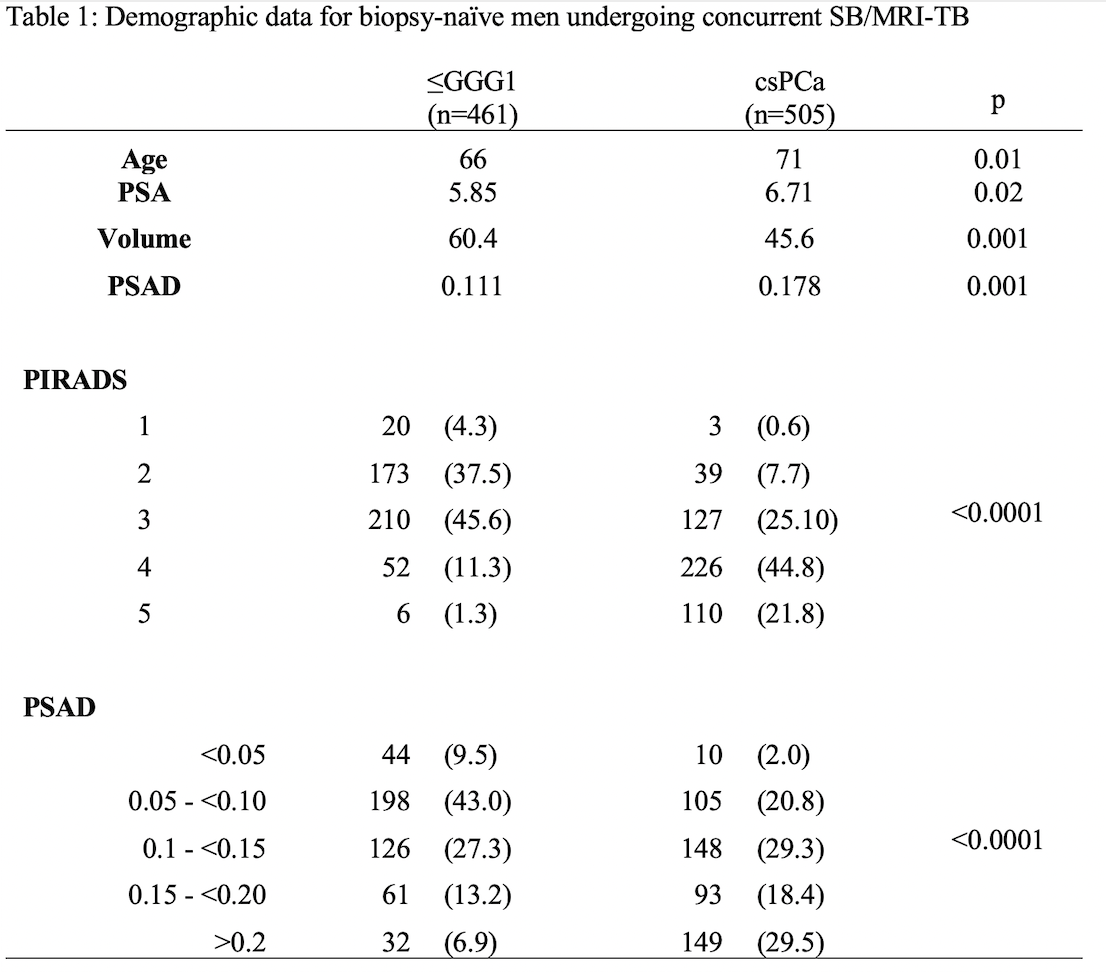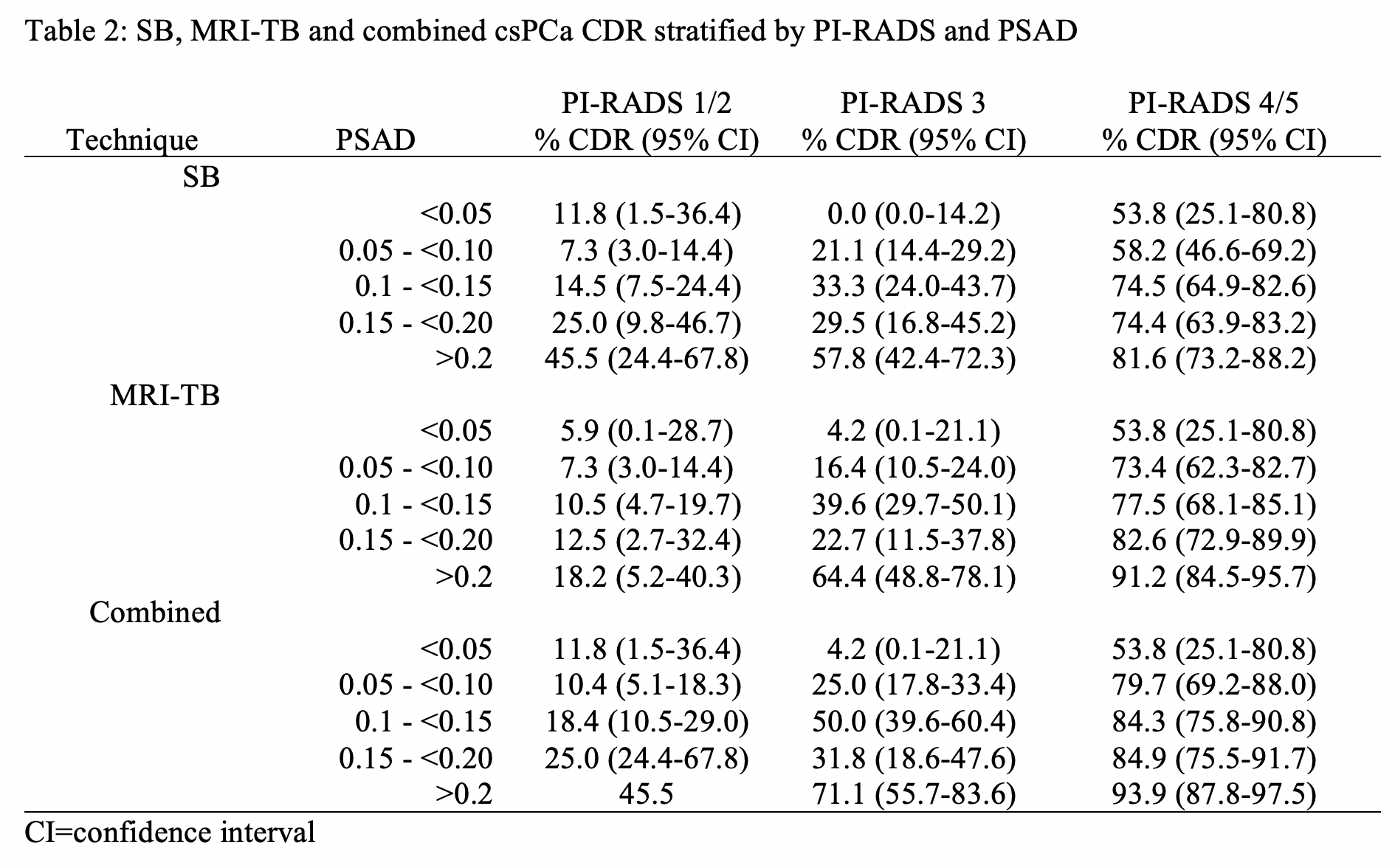Back
Poster, Podium & Video Sessions
Moderated Poster
MP58: Prostate Cancer: Detection & Screening VII
MP58-07: Clinically Significant Prostate Cancer Detection Rate by PI-RADS Score and PSA-Density: A Descriptive Analysis
Monday, May 16, 2022
1:00 PM – 2:15 PM
Location: Room 228
Zachary Feuer*, Richard Huang, Fang-Ming Deng, James Wysock, William Huang, Samir Taneja, New York, NY
- ZF
Zachary Feuer, MD, BS
NYU Langone Health
Poster Presenter(s)
Introduction: MRI has been widely adopted as a risk stratification tool. Previously, PSA and various PSA-associated calculations, including PSA-density (PSAD), were used to estimate the risk of harboring clinically significant prostate cancer (csPCa). Using MRI-based prostate volume measurements (MRI-PV), we aim to describe the cancer detection rate (CDR) for MRI-targeted biopsy MRI-TB, systematic biopsy (SB), and combined biopsy stratified by PSA density and PI-RADS score.
Methods: This study included all men with no prior biopsy and PI-RADS =3 pre-biopsy MRI undergoing concurrent SB/MRI-TB between 2/2015-9/2019. Men without concurrent SB and MRI-TB or no MRI-PV were excluded. csPCa was defined as =Gleason grade group (GGG) 2. PI-RADS scores were collated into three groups, PI-RADS 1/2 PI-RADS 3 and PI-RADS 4/5. PSAD was calculated using pre-biopsy PSA and MRI-PV. csPCa CDR were calculated for combined, and unique SB and MRI-TB biopsy results. Medians were compared using the Mann-Whitney test.
Results: 966 biopsy-naïve men were included. Demographic information is summarized (Table 1). Amongst men with PI-RADS 1/2 MRI, CDR, regardless of PSAD strata was <50%, with the highest CDR amongst men with PSAD >0.20. For men with PI-RADS 3 MRI, CDR was 4.2% amongst men with PSAD <0.05, while CDR was >25% men with PSAD >0.05, with CDR 71.1% amongst men with PSAD >0.20. Men with PI-RADS 4/5 MRI were noted to have CDR >50% regardless of PSAD strata. SB CDR was noted to be higher within the same PSAD strata as compared to MRI-TB. Conversely, within the same PSAD strata, MRI-TB CDR was higher than SB CDR (Table 2).
Conclusions: This study demonstrated increasing CDR with increasing PSAD intervals amongst men, stratified by PI-RADS. SB demonstrated higher CDR amongst men with PI-RADS 1/2 MRI, while MRI-TB demonstrated higher CDR amongst men with PI-RADS 4/5 MRI. Given the large number of biopsy naïve men included, this study may serve as a reference to counsel patients regarding their csPCa risk using only pre-biospy PSA and MRI.
Source of Funding: Joseph and Diane Steinberg Charitable Trust


Methods: This study included all men with no prior biopsy and PI-RADS =3 pre-biopsy MRI undergoing concurrent SB/MRI-TB between 2/2015-9/2019. Men without concurrent SB and MRI-TB or no MRI-PV were excluded. csPCa was defined as =Gleason grade group (GGG) 2. PI-RADS scores were collated into three groups, PI-RADS 1/2 PI-RADS 3 and PI-RADS 4/5. PSAD was calculated using pre-biopsy PSA and MRI-PV. csPCa CDR were calculated for combined, and unique SB and MRI-TB biopsy results. Medians were compared using the Mann-Whitney test.
Results: 966 biopsy-naïve men were included. Demographic information is summarized (Table 1). Amongst men with PI-RADS 1/2 MRI, CDR, regardless of PSAD strata was <50%, with the highest CDR amongst men with PSAD >0.20. For men with PI-RADS 3 MRI, CDR was 4.2% amongst men with PSAD <0.05, while CDR was >25% men with PSAD >0.05, with CDR 71.1% amongst men with PSAD >0.20. Men with PI-RADS 4/5 MRI were noted to have CDR >50% regardless of PSAD strata. SB CDR was noted to be higher within the same PSAD strata as compared to MRI-TB. Conversely, within the same PSAD strata, MRI-TB CDR was higher than SB CDR (Table 2).
Conclusions: This study demonstrated increasing CDR with increasing PSAD intervals amongst men, stratified by PI-RADS. SB demonstrated higher CDR amongst men with PI-RADS 1/2 MRI, while MRI-TB demonstrated higher CDR amongst men with PI-RADS 4/5 MRI. Given the large number of biopsy naïve men included, this study may serve as a reference to counsel patients regarding their csPCa risk using only pre-biospy PSA and MRI.
Source of Funding: Joseph and Diane Steinberg Charitable Trust



.jpg)
.jpg)